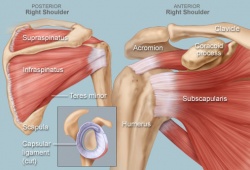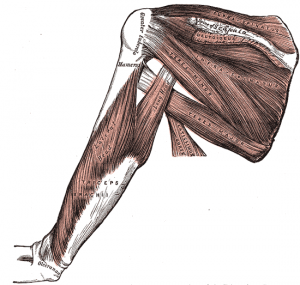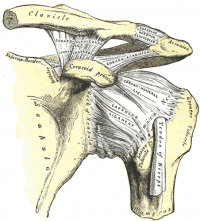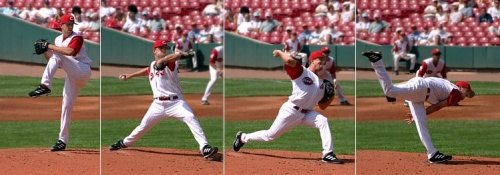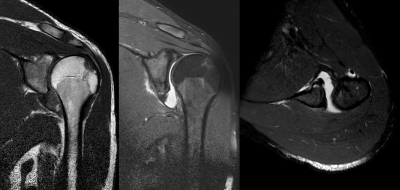Anterior Shoulder Instability
Original Editors - Liesbeth De Feyter
Top Contributors - Daphné Bertrand, Lisa De Pelsemaeker, Arnaud Jacquet
Definition:[edit | edit source]
Anterior shoulder instability is an injury to the shoulder joint so that the upper arm (humerus) is displaced from its normal position in the center of the socket (glenoid) and the joint surfaces no longer touch each other.[1]
Clinically Relevant Anatomy[edit | edit source]
The shoulder is one of the largest and most complex joints in the body. The shoulder joint is formed where the humerus (upper arm bone) fits into the scapula (shoulder blade), like a ball and socket. Other important bones in the shoulder include:
The acromion is a bony projection off the scapula.
The clavicle (collarbone) meets the acromion in the acromioclavicular joint.
The coracoid process is a hook-like bony projection from the scapula.
The shoulder has several other important structures:
The rotator cuff is a collection of muscles(supraspinatus,infraspinatus,subscapularis and teres minor) and tendons that surround the shoulder, giving it support and allowing a wide range of motion.
The bursa is a small sac of fluid that cushions and protects the tendons of the rotator cuff.
A cuff of cartilage called the labrum forms a cup for the ball-like head of the humerus to fit into.[2]
Epidemiology /Etiology[edit | edit source]
Epidemiology
Anterior shoulder dislocations are much more common than posterior dislocations.[3]
Many investigators have shown that the incidence of recurrent shoulder dislocation is significantly higher in younger patients.[4][5] The consequences of initial anterior glenohumeral dislocation in patients over forty years of age are quite different than in the younger population, primarily because of the increased incidence of rotator cuff tears and associated neurovascular injuries. The anterior or posterior supporting structures of the shoulder can be disrupted following an anterior dislocation. In the younger patient, anterior capsuloligamentous structures most commonly fail. In the older patient with pre-existing degenerative weakening of the rotator cuff, the posterior structures are more likely to fail.[4]
Etiology
The glenohumeral joint is stabilized by dynamic and static structures.
- Dynamic stabilizers: rotator cuff muscles, biceps brachii, deltoid
- Static stabilizers: glenohumeral joint capsule, the glenohumeral ligaments, the labrum, negative pressure within the joint capsule, and the bony congruity of the joint[3][5]
- The labrum: The concavity compression mechanism plays an important role in the stability of the glenohumeral joint by maintaining the localization of the humeral head at the glenoid against translational forces. The glenoid concavity is established by the glenoid shape, the glenoid cartilage and the glenoid labrum. The glenoid labrum increases the width and depth of the glenoid. Instability increased with the size of the glenoid defect.[6]
- The glenohumeral ligaments: The superior glenohumeral ligament functions primarily to resist inferior translation and external rotation of the humeral head in the adducted arm. The middle glenohumeral ligament functions primarily to resist external rotation from 0° to 90° and provides anterior stability to the moderately abducted shoulder. The inferior glenohumeral ligament is composed of two bands, anterior and posterior, and the intervening capsule. The primary function of the anterior band is to resist anteroinferior translation.[5].[7]
- Excessive external rotation or over-rotation of the thrower’s shoulder is purportedly associated with the development of internal impingement syndrome (which occurs when the shoulder is maximally externally rotated and the intra-articular side of the supraspinatus tendon impinges on the adjacent posterior superior glenoid and glenoid labrum). Impingement syndrome is a potential precursor to anterior instability.[7]
Characteristics/Clinical Presentation[edit | edit source]
Signs and symptoms for anterior shoulder instability:
- Anterior instability accounts for 95% of acute traumatic dislocations.[5]
- Dead-arm syndrome indicates pathologic anterior instability. It occurs when the arm is in an abducted, externally rotated position. The patient complains of a sharp anterior shoulder pain and tingling in the hand. The patient drops the arm suddenly. This syndrome can be seen in overhead sports, such as volleyball, tennis, swimming and water polo.[7]
- Rotator cuff weakness, particularly in external rotation and “empty-can” abduction, is common in athletes with anterior instability.[7]
- Bankart lesions are the most common sequelae of traumatic anterior shoulder instability.[5]
- Humeral avulsion of glenohumeral ligaments lesions are a known cause of anterior shoulder instability.[5].[5]
- During an anterior dislocation, the posterolateral aspect of the humeral head contacts the anteroinferior rim of the glenoid, often resulting in a classic Hill-Sachs defect. This defect has been observed in up to 80% of patients with initial anterior dislocation and in 100% of patients with recurrent anterior instability.[3][5]
Complaints related to recurrent anterior instability:[7]
- Glenohumeral joint pain
- Shoulder stiffness with difficulty warming up for the sport
- Rotator cuff weakness
- Sensation of popping, grinding or catching deep in the shoulder joint
- Pain when reaching backward or above shoulder height
- Apprehension when sleeping with the arm overhead in abduction and external rotation
- Neurologic complaints: tingling or burning in the lower arm and hand or localized numbness of the skin overlying the deltoid muscle
- Tenderness of the anterior glenohumeral joint line and the posterior rotator cuff
Differential Diagnosis[edit | edit source]
• Posterior instability
• Frozen shoulder/adhesive capsulitis
• Dead arm syndrome
• Rotator cuff tear
• Sub acromial impingement
•Internal impingement
•Biceps tendonitis
Diagnostic Procedure[edit | edit source]
Diagnosis of anterior shoulder instability is done by history, radiology and through three tests performed in respective order: apprehension, relocation and surprise (release) test. According to Lo IK et al.[8] is a positive instability exam on all three test highly specific and predictive of traumatic anterior glenohumeral instability. A last test, the bony apprehension test, is a test similar to the apprehension test but to diagnose instability paired with a significant osseous lesions.
History:[9]
Glenohumeral instability can be categorized by the direction of instability, the chronicity, and the etiology. A thorough history and physical examination are thus essential. Age, activity level, sports participation, and hand dominance should be noted. The examiner should inquire about instability in the other joints, especially the contralateral shoulder. If a traumatic event is related to the patient’s symptoms, the position of the arm and amount of energy involved during the event should be noted. If the patient cannot remember the position of the arm during the event, knowing the position of the arm that reproduces symptoms is also useful.
One should inquire about the presence and quantity of previous shoulder subluxations or dislocations. Information regarding all treatment prior to presentation should be ascertained, including any period of immobilization or physical therapy, and previous operative interventions. The characteristics of associated pain should be noted, however, the location of pain is not a specific indicator of glenohumeral instability. A distinction should be made between episodes of subluxation, or partial separation of the humeral head from the glenoid, and dislocation. The examiner should inquire about any associated symptoms including neurologic deficits and functional limitations. Age of the patient at the first dislocation is a very important prognostic indicator. Patients with shoulder dislocations younger than 20 years old have a 90% rate of recurrence, while patients older than 40 years have only a 10% recurrence rate but are more prone to rotator cuff injuries. Patients that compete in high level and contact sports are also at an increased risk of recurrence if treated nonoperatively
Radiology:[9]
The initial radiologic studies in patients with glenohumeral instability are plain radiographs with anteroposterior (AP) and axillary lateral views. If the patient cannot tolerate an axillary lateral view in the acute setting due to pain, a Velpeau view may be obtained with them in a semi-reclined, seated position. Further views that may be useful include AP views with the shoulder internally rotated, a West Point view, a Didiee view, and a Stryker notch view. With anterior shoulder dislocations the posterolateral aspect of the humeral head can be impacted against the glenoid rim causing an impaction fracture to the posterior aspect of the humeral head known as a Hill-Sachs lesion. If this bony concavity engages the anterior glenoid with the arm in 90° and external rotation it is term an “Engaging Hill Sachs Lesion”, and confers a higher risk of failure following an arthroscopic stabilization procedure. Hill-Sachs lesions are best viewed on AP radiographs in internal rotation and Stryker notch views. The Stryker notch view is obtained with the patient in the supine position and the arm forward flexed to 100° with the x-ray beam centered over the coracoid and tilted 10° cephalad. An apical oblique view taken with the patient seated and rotated 45° and the beam directed 45° caudally is also useful for evaluating posterior humeral head defects.[10]
Traumatic dislocations can fracture the glenoid rim. An avulsion fracture of the anteroinferior glenoid at the insertion of the IGHL is referred to as a bony Bankart lesion. Recurrent instability can cause erosive or attritional loss of the glenoid rim causing progressive instability. Loss of 20% of the glenoid rim has been shown to cause significant recurrent instability and usually requires surgical correction of the bony deficiency. This deficiency may be seen on the axillary view and may be suggested by a break in the sclerotic line encircling the glenoid rim on the AP view of the shoulder. If further investigation is needed one can also consider Didiee and West Point views. The Didiee view is obtained with the patient prone and the hand is placed on the ipsilateral iliac crest with the x-ray beam directed laterally at 45° to the floor. The West Point view is obtained with the patient prone, with the shoulder abducted to 90° and the elbow bent with the arm hanging off the table. The x-ray beam is directed 25° medial and 25° caudal.
Other imaging modalities including computed tomography (CT) and magnetic resonance imaging (MRI) are useful in clinical situations where the diagnosis is unclear. CT may be useful to demonstrate and quantify bony abnormalities including glenoid bone loss or fractures, glenoid version and humeral head abnormalities. Adding contrast and performing a CT arthrogram of the shoulder can also provide some insight into the status of the labrum, rotator cuff and ligamentous complex. MRI is extremely useful, and the preferred method to evaluate these soft tissues, however, it does not provide as clear a picture of the associated bony injuries. In the acute setting, the hemarthrosis resulting from the dislocation serves as an intra-articular contrast medium. In the more chronic setting, gadolinium-enhanced MRI is a useful modality to investigate for soft tissue pathology such as labral tears and capsular damage.[11]
In addition to the commonly discussed Bankart lesion (avulsion or tear of the anteroinferior glenoid labrum), an anterior periostial sleeve avulsion (ALPSA) or a humeral avulsion of glenohumeral ligament (HAGL) can occur with an anterior shoulder dislocation. These are associated with higher recurrence rates and if gone unnoticed can lead to higher post-surgical failure rates. HAGL and ALPSA lesions are best seen using advanced imaging techniques such as MRI and MR arthrogram.
Bony Apprehension test:[12]
To perform the test, the examiner places the patient supine on the examination table with the shoulder just off the edge of the table. Alternatively, the patient may be examined in a seated or standing position with the examiner behind the patient. The arm is gradually brought into combined abduction and external rotation. Once the full “position of athletic function”7 of 90° of abduction and 90° of external rotation is reached, the examiner applies gentle anteriorly directed force to the posterior humerus to re-create the anterior dislocation/subluxation moment. During the test, the examiner questions the patient about the presence of a sensation of apprehension that the shoulder is going to dislocate. A positive subjective response from the patient indicates a positive test.
Outcome Measures[edit | edit source]
The Disabilities of the Arm, Shoulder and Hand (DASH) questionnaire :
is a 30-item questionnaire that looks at the ability of a patient to perform certain upper extremity activities. This questionnaire is a self-report questionnaire that patients can rate difficulty and interference with daily life on a 5 point Likert scale.
A Visual Analogue Scale (VAS):
is a measurement instrument that tries to measure a characteristic or attitude that is believed to range across a continuum of values and cannot easily be directly measured. It is often used in epidemiologic and clinical research to measure the intensity or frequency of various symptoms. For example, the amount of pain that a patient feels ranges across a continuum from none to an extreme amount of pain. From the patient's perspective this spectrum appears continuous ± their pain does not take discrete jumps, as a categorization of none, mild, moderate and severe would suggest. It was to capture this idea of an underlying continuum that the VAS was devised.
Examination[edit | edit source]
Load and shift test: [13][14]
you can perform the load and shift test with the patient sitting or supine. In sitting, the patient’s arm rest on the thigh while you stand at his side and slightly behind him. To perform the test, use one hand to stabilize his scapula and clavicle and use the other as your test hand. Place your test hand on the shoulder with your thumb over the posterior humeral head and your fingers over the anterior humeral head. Load the humerus by pushing the humeral head into the fossa gleanoidale to seat it in the neutral position. While maintaining the humeral head in a seated position, shift the humerus forward by applying anterior force to asses anterior instability. Some movement is normal, but it should not be more than 25% of the humeral head. Grade 1 instability is present if the humeral head mover 25% to 50%, grade 2 is present with more than 50% movement with spontaneous reduction when the force is stopped, grade 3 is present when the humeral head shows more than 50% movement without spontaneous reduction and remains dislocated. A combination of laxity and reproduction of the symptoms determines wether or not the test is positive
Apprehension, Relocation and anterior release tests:[14][15]
The position for this test is the patient in a supine position, the shoulder in 90° abduction and maximal lateral rotation. A positive apprehension test occurs if the patient either looks apprehensive or resists further movement. To differentiate the apprehension from other potential conditions, continue with the relocation test. Create the same position of apprehension, then apply an anterior-posterior force to the shoulder to relocate the humerus in the fossa glenoidale. The apprehension will diminish if it is due instability. The final progression of tests is the release test. In this test, the posterior directed force used in the relocation test is suddenly removed and is considerd positive if the patient’s apprehension returns.
Anterior drawer test: [16][8]
The patient is in a supine postition and the affected shoulder over the edge of the table. the patient’s arm should be relaxed. Position the arm in midrange abduction with forward flexion and lateral rotation. Place the stabilizing hand on the scapula so that the fingers and thumb secure the scapula at the spine of the scapula and the proccesus coracoideus. Pull the patient’s arm anteriorly to apply a glide force to the glenohumeral joint. If you hear a click during the maneuver, the glenoid labrum may be torn, or the joint may be sufficiently lax to allow the humeral head to glide over the glenoid labrum rim.
Medical Management[edit | edit source]
In patients with shoulder dislocation, stabilize and treat associated trauma as indicated.Allow the patient to assume a position of comfort while maintaining cervical spine immobilization if necessary.A pillow between the patient's arm and torso may increase comfort.Administer analgesics to decrease pain.[17]
Physical Therapy Management[edit | edit source]
Non-operative rehabilitation is utilized in patients diagnosed with shoulder instability to regain their previous functional activities through specific strengthening exercises, dynamic stabilization drills, neuromuscular training, proprioception drills, scapular muscle strengthening program and a gradual return to their desired activities. The specific rehabilitation program should be varied based on the type and degree of shoulder instability present and desired level of function.
REHABILITATION FACTORS
Seven key factors should be considered when designing a rehabilitation program for a patient with an unstable shoulder:
1. Onset of Pathology: Pathological shoulder instability may result from an acute, traumatic event or chronic, recurrent instability. The goal of the rehabilitation program may vary greatly based on the onset and mechanism of injury. Following a traumatic subluxation or dislocation, the patient typically presents with significant tissue trauma, pain, and apprehension. Rehabilitation for the patient with a first-time traumatic episode will be progressed based on the patient's symptoms with emphasis on early controlled range of motion, reduction of muscle spasms and guarding, and relief of pain.
Conversely, a patient presenting with atraumatic instability often presents with a history of repetitive injuries and symptomatic complaints. Rehabilitation for this patient should focus on early proprioception training, dynamic stabilization drills, neuromuscular control, scapular muscle exercises, and muscle strengthening exercises to enhance dynamic stability due to the unique characteristic of excessive capsular laxity and capsular redundancy in this type of patient.
2. Degree of Instability: The second factor is the degree of instability present in the patient and the effect on their function.
The rate of progression of the rehabilitation program will vary based upon the degree of instability and persistence of symptoms. For example, a patient with mild subluxations and muscle guarding may initially tolerate strengthening exercises and neuromuscular control drills more than a patient with a significant amount of muscular guarding.
3. Frequency of Dislocation: The next factor to influence the rehabilitation program is the frequency of dislocation or subluxation. The primary traumatic dislocation is most often treated conservatively with immobilization in a sling and early controlled passive range of motion (ROM) exercises, especially with first time dislocations. Chronic subluxations, as seen in the atraumatic, unstable shoulder may be treated more aggressively due to the lack of acute tissue damage and less muscular guarding and inflammation. Rotator cuff and periscapular strengthening activities should be initiated while ROM exercises are progressed. Caution is placed on avoiding excessive stretching of the joint capsule through aggressive ROM activities. The goal is to enhance strength, proprioception, dynamic stability and neuromuscular control, especially in the specific points of motion or direction which results in instability complaints.
4.Direction of Instability: Anterior instability is the most common traumatic type of instability seen in the general orthopaedic population. Following a traumatic event in which the humeral head is forced into extremes of abduction and external rotation, or horizontal abduction, the glenolabral complex and capsule may become detached from the glenoid rim resulting in anterior instability. This type of detachment is referred to a Bankart lesion.
5. Concomitant Pathologies: The fifth factor involves considering other tissues that may have been affected and the premorbid status of the tissue. These concomitant lesions may significantly slow down the rehabilitation program in order to protect the healing tissue.
6. Neuromuscular control: The sixth factor to consider is the patient's level of neuromuscular control, particularly at end range.
7. Activity Level: The final factor to consider in the non-operative rehabilitation of the unstable shoulder is the arm dominance and the desired activity level of the patient. If the patient frequently performs an overhead motion or sporting activities such as a tennis, volleyball, or a throwing sport, then the rehabilitation program should include sport specific dynamic stabilization exercises, neuromuscular control drills, and plyometric exercises in the overhead position once full, pain free ROM and adequate strength has been achieved. Patients whose functional demands involve below shoulder level activities will follow a progressive exercise program to return full ROM and strength.
REHABILITATION GUIDELINES
Patients may be classified into two common forms of shoulder instability - traumatic and atraumatic. Specific guidelines to consider in the rehabilitation of each patient population will be outlined.
Traumatic Shoulder Instability
The program will vary in length for each individual depending on the seven rehabilitation factors.
-Phase I: Acute Motion phase
Goals:
• Protect healing capsular structures
• Re-establish non-painful range of motion
• Decrease pain, inflammation, and muscular spasms
• Retard muscular atrophy / Establish voluntary muscle activity
• Reestablish dynamic stability
• Improve proprioception
Exercises:
• Range of motion: pendulums, rope & pulley, active-assisted ROM (flexion, IR, ER)
• Strengthening/proprioception: isometrics (flexion, abduction, extension, IR, ER,… --> performed with arm et side)
• Rhythmic stabilization: ER/IR/Flex/Ext in scapular plane, weight shifts (standing hands on table), proprioception training drills (active joint reproduction: Flex/ IR/ER)
Note: During the early rehabilitation program, caution must be applied in placing the capsule under stress until dynamic joint stability is restored. It is important to refrain from activities in
DO NOT PUSH INTO ER OR HORIZONTAL ABDUCTION with anterior instability
-Phase II: Intermediate Phase
Goals:
• Regain and improve muscular strength
• Normalize arthrokinematics
• Enhance proprioception and kinesthesia
• Enhance dynamic stabilization
• Improve neuromuscular control of shoulder complex
Exercises:
• Progress ROM activities at 90° abduction to tolerance (painfree)
• Initiate isotonic strengthening
• Emphasis on ER and scapular strengthening: abduction to 90°, ER/IR tubing, sideling ER to 45°, push-ups onto table, biceps curls, triceps pushdowns, prone rowing,…
• Improve neuromuscular control of shoulder complex: PNF, wall stabilization on ball, static holds in push-up position on ball, core
Criteria to Progress to Phase II:
• Nearly Full to Full Passive ROM (External Rotation may be still limited)
• Minimal Pain or Tenderness
• “Good” MMT of Internal Rotation, External Rotation, Flexion, and Abduction
• Baseline proprioception and dynamic stability
-Phase III: ADVANCED Strengthening Phase
Goals:
• Improve strength/power/endurance
• Improve neuromuscular control
• Enhance dynamic stabilizations
• Prepare patient/athlete for activity
Exercises:
• Continue isotonic strengthening (progress resistance): full ROM strengthening, bench press in restricted ROM, flat and incline chest press
• Emphasize PNF
• Advanced neuromuscular control drills: ball flips on table, push-ups on ball with rhythmic stabilizations, manual scapular neuromuscular control drills, intiate perturbation activities
• Endurance training: timed bouts of exercises (30-60sec), increase number of repetitions, multiple bouts throughout day
• Initiate plyometric training: 2 hand-drills (chest pass throw, side to side throw, overhead soccer throw) and progress to 1hand-drills (wall dribbles, 90/90 baseball throws)
Criteria to Progress to Phase III:
• Full non-painful range of motion
• No palpable tenderness
• Continued progression of resistive exercises
• Good - normal muscle strength, dynamic stability, neuromuscular control
-Phase IV - RETURN TO ACTIVITY PHASE
Goals:
• Maintain optimal level of strength/power/endurance
• Progressively increase activity level to prepare patient/athlete for full functional return to activity/sport
Exercises:
• Continue all ex as in phase III
• Progress isotonic strengthening exercises
• Resume normal lifting program
• Initiate interval sport program
Criteria to Progress to Phase IV:
• Full ROM
• No pain or palpable tenderness
• Satisfactory isokinetic test
• Satisfactory clinical exam
-FOLLOW-UP
• Isokinetic Test (ER/IR & Abd/Add)
• Progress Interval Program
• Maintenance of Exercise Program
Atraumatic Instability
This multi-phased program is designed to allow the patient/athlete to return to their previous functional level as quickly and safely as possible. Each phase will vary in length for each individual depending upon the severity of injury, ROM/strength deficits, and the required activity demands of the patient.
PHASE I - ACUTE PHASE
Goals:
• Decrease pain/inflammation
• Re-establish functional range of motion
• Establish voluntary muscular activation
• Re-establish muscular balance
• Improve proprioception
• Decrease Pain/Inflammation
• -Therapeutic modalities (ice, electrotherapy, etc.)
• -NSAIDs
• -Gentle joint mobilizations (Grade 1 and II) for neuromodulation of pain
Exercises:
• ROM exercises: pendulum, rope and pulley
• Strengthening exercises: isometric, Flex, Abd, Ext,…
• Proprioception
• Active joint reposition drills for ER/IR
NOTE: refrain activities and motion in extreme ROM
PHASE II - INTERMEDIATE PHASE
Goals:
• Normalize arthrokinematics of shoulder complex
• Regain and improve muscular strength of glenohumeral and scapular muscle
• Improve neuromuscular control of shoulder complex
• Enhance proprioception and kinesthesia
Exercises:
• Initiate isotonic strengthening: IR/ER (sideling dumbbell), Abd to 90°, …
• Initiate eccentric exercises at ZERO degrees Abd: IR/ER
• Improve neuromuscular control of shoulder complex: rhythmic stabilization drills at inner, mid, and outer ROM, proprioceptive, scapulothoracic/glenohumeral musculature, PNF, weight shifts hand on ball, wall stabilization drills
Criteria to Progress to Phase II:
• Full functional ROM
• Minimal pain or tenderness
• “Good” MMT
PHASE III - ADVANCED STRENGTHENING PHASE
Goals:
• Enhance dynamic stabilization
• Improve strength/endurance
• Improve neuromuscular control
• Prepare patient for activity
Exercises:
• Continue isotonic strengthening
• Continue eccentric strengthening
• Emphasize PNF exercises with rhythmic stabilization hold
• Continue to progress neuromuscular control drills: push-ups with rhythmic stabilization, progress to unsteady surface, medicine ball, rocker board
• Program scapular neuromuscular control training: sideling manual drills
• Emphasize endurance training: time bouts of exercise (30-60sec), increase number of reps
Criteria to Progress to Phase III:
• Full non-painful ROM
• No pain or tenderness
• Continued progression of resistive exercises
• Good to normal muscle strength
Phase IV - RETURN TO ACTIVITY PHASE
Goals:
• Maintain optimal level of strength/power/endurance
• Progressively increase activity level to prepare patient/athlete for full functional return to activity/sport
Exercises:
• Continue all exercises as in phase III
• Initiate interval sport program
• Patient education
Criteria to Progress to Phase IV:
• Full ROM
• No pain or palpable tenderness
• Satisfactory isokinetic test
• Satisfactory clinical exam[18][19]
MORE exercises see: http://www.orthopedicsports.com/wp-content/themes/ypo-theme/pdf/treatment-instability-shoulder-exercise-program.pdf
Key evidence[edit | edit source]
Anterior shoulder instability: a review of pathoanatomy, diagnosis and treatment, Guillaume D. Dumont, Robert D. Russell, William J. Robertson
Clinical Bottom Line[edit | edit source]
• Shoulder instability may have a traumatic or atraumatic cause.
• Anterior shoulder instability is an injury to the shoulder joint so that the upper arm (humerus) is displaced from its normal position in the center of the socket (glenoid) and the joint surfaces no longer touch each other
• Anterior shoulder dislocations are much more common than posterior dislocations.
The recurrence rate after primary shoulder dislocation is greatest in individuals <20 years old. Anterior instability accounts for 95% of acute traumatic dislocations.
• Diagnosis of anterior shoulder instability is done by history, radiology and through three tests performed in respective order: apprehension, relocation and surprise (release) test.
• Rehab should be based on each patient’s case with consideration to the patient’s preference.
References[edit | edit source]
- ↑ Washington Orthopaedics & Sports Medicine http://www.wosm.com/index.php/health-library/orthopaedic-conditions-and-treatments/147-anterior-shoulder-instability
- ↑ http://www.webmd.com/pain-management/picture-of-the-shoulder
- ↑ 3.0 3.1 3.2 Chen AL,Bosco JA. Glenohumeral Bone Loss and Anterior Instability. Bull Hosp Jt Dis. 2006; 64(3-4):130-138.
- ↑ 4.0 4.1 Araghi A, Prasarn M, St Clair S, Zuckerman JD. Recurrent anterior glenohumeral instability with onset after forty years of age: the role of the anterior mechanism. Bull Hosp Jt Dis. 2005;62(3-4):99-101.
- ↑ 5.0 5.1 5.2 5.3 5.4 5.5 5.6 5.7 Pope EJ, Ward JP, Rokito AS. Anterior shoulder instability - a history of arthroscopic treatment. Bull NYU Hosp Jt Dis. 2011;69(1):44-9.
- ↑ Rhee YG, Lim CT. Glenoid defect associated with anterior shoulder instability: results of open Bankart repair. Int Orthop. 2007;31(5):629-34.
- ↑ 7.0 7.1 7.2 7.3 7.4 Satterwhite YE.Evaluation and management of recurrent anterior shoulder instability. J Athl Train. 2000;35(3):273-277.
- ↑ 8.0 8.1 Lo Ik, Nonweiler B, Woolfrey M, Litchfield R, Kirkley A. An evaluation of the apprehension, relocation and surprise tests for anterior shoulder instability. Am J Sports Med. 2004; 32:301-307
- ↑ 9.0 9.1 Guillaume D. Dumont, Robert D. Russell, William J. Robertson. Anterior shoulder instability: a review of pathoanatomy, diagnosis and treatment
- ↑ The roentgenographic evaluation of anterior shoulder instability. Pavlov H, Warren RF, Weiss CB Jr, Dines DM
- ↑ Modified axillary roentgenogram. A useful adjunct in the diagnosis of recurrent instability of the shoulder. Rokous JR, Feagin JA, Abbott HG
- ↑ The bony apprehension test for instability of the shoulder: a prospective pilot analysis, Bushnell BD1, Creighton RA, Herring MM
- ↑ Sandra J.shultz, Peggy A.Houglum, David H.Perrin. Examination of musculoskeletal injuries (2005)
- ↑ 14.0 14.1 Clinical assessment of three common tests for traumatic anterior shoulder instability. Farber AJ1, Castillo R, Clough M, Bahk M, McFarland EG
- ↑ Anterior instability in the throwing shoulder. Savoie FH 3rd1, O'Brien MJ
- ↑ The supine apprehension test helps predict the risk of recurrent instability after a first-time anterior shoulderdislocation. Milgrom C, Milgrom Y, Radeva-Petrova D
- ↑ Shoulder Dislocation in Emergency Medicine Treatment & ManagementfckLRAuthor: Sharon R Wilson, MD; Chief Editor: Trevor John Mills, MD, MPH
- ↑ Kevin E. et al., Non-operative rehabilitation for traumatic and atraumatic glenohumeral instability, 2006 (level of evidence 2C)
- ↑ Burkhead et al., Treatment of Instability of the Schoulder with an Exercise program, 1992 (level of evidence 2B)
